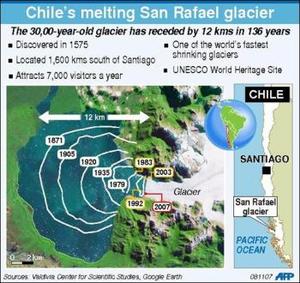"How can we stop this," asked German visitor Herman Kirst, 70, reflecting on the 100 meters (yards) that the glacier has shrunk this year, and every year since Captain Luis Kochifas began ferrying tourists to this spot in 1978.

|
| ©AFP |
| Graphic showing Chile's 30,000-year-old San Rafael glacier, which has receded 12 kilometres since 1871. |
"How sad, how devastating it is to think that all this, one day, could disappear," added Kirst, after being told the 30,000-year-old glacier has receded a total of 12 kilometers (7.5 miles) since 1871.
Global warming, Chilean scientists say, has done the most damage to the glacier, which lies 1,600 kilometers (1,000 miles) south of Santiago.
With the rising temperatures, more melting occurs at the face, sending huge icebergs crashing into the ocean reflecting the sun's rays in blue and turquoise.
UN chief Ban Ki-moon is to visit Chile next week as part of tour of the region to investigate the effects of global warming, which will take him from the steamy heat of the Amazon to the frozen wastes of Anarctica.
But at the helm of the Skorpios II, Kochifas has been navigating for years through the majestic islands of ice at the edge of the glacier to within 500 meters from the face of the glacier, an imposing wall of ice two kilometers (1.2 miles) across.
Kochifas said he and his crew have been taking the pulse of the glacier's retreat and are keen to convey their concern to the thousands of tourists they bring each year to this top tourist destination in Chile's southern Patagonia.
"We don't want the tourists only to see how beautiful the glacier is, but to also to be aware" of how its shrinking, the captain told AFP.
Bundled up in heavy coats, gloves, hats and bulky life jackets, the tourists lower themselves into a smaller power boat for a close-up look at San Rafael.
Since first sailing here in 1978, Kochifas and his crew have been planting markers on the mountains surrounding the San Rafael Laguna to show where the glacier ended in the past: there are markers for 1978, 1982, 1985, 1989 and 2000.
Each time he reaches the laguna with a boatload of tourists, he points to the markers as tangible proof of the effects of global warming.
"It's not a joke. It's real," he tells them.
The San Rafael glacier and its 741 square kilometers (286 square miles) has been receding at a steady pace of 100 linear meters per year, said the descendant of Greek immigrants, who have made their fortune from tourism in the region.
"San Rafael glacier is in tune with the majority of Chile's glaciers that are also undergoing a process of retreat," Valdivia city's Scientific Research Center glaciologist Andres Rivera told AFP.
The glaciers "are not in balance with current climatic conditions," he added, because rising temperatures above all else are making it difficult for new ice build-up to offset losses from when chunks break off, known as calfing, and melting.
Calfing is further accelerated by the lagoon floor's steep drop at the glacier face, which can reach 270 meters (886 feet) in depth, Rivera said.
After drinking their whisky and listening to the thunderclaps of huge slabs of ice shearing off the glacier, and splashing into the cold lagoon water, the tourists sped back to the Skorpios II for their return to the mainland.
Despite many studies it is impossible to measure how fast the San Rafael glacier will continue receeding because nobody has determined where exactly it stops floating on the lagoon and starts its climb up the Andes mountains, Rivera said.
"It's not easy to make a model on the future of this glacier, or determine when it will stop calfing icebergs," he said.
"But if current climate conditions and warming trend continue, it's quite likely this and other glaciers in the Campo de Hielo Norte region will continue to retreat."



Reader Comments
to our Newsletter